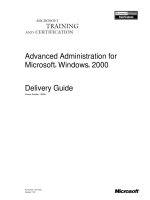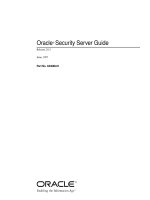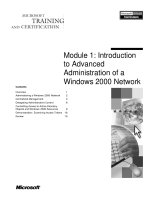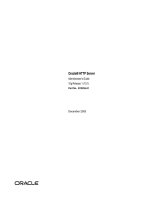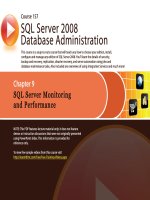oracle weblogic server 12c advanced administration cookbook
Bạn đang xem bản rút gọn của tài liệu. Xem và tải ngay bản đầy đủ của tài liệu tại đây (3.17 MB, 285 trang )
www.it-ebooks.info
Oracle WebLogic
Server 12
c
Advanced
Administration
Cookbook
Over 60 advanced recipes to congure, troubleshoot,
and tune Oracle WebLogic Server
Dalton Iwazaki
BIRMINGHAM - MUMBAI
www.it-ebooks.info
Oracle WebLogic Server 12
c
Advanced
Administration Cookbook
Copyright © 2013 Packt Publishing
All rights reserved. No part of this book may be reproduced, stored in a retrieval system,
or transmitted in any form or by any means, without the prior written permission of the
publisher, except in the case of brief quotations embedded in critical articles or reviews.
Every effort has been made in the preparation of this book to ensure the accuracy of the
information presented. However, the information contained in this book is sold without
warranty, either express or implied. Neither the author, nor Packt Publishing, and its dealers
and distributors will be held liable for any damages caused or alleged to be caused directly
or indirectly by this book.
Packt Publishing has endeavored to provide trademark information about all of the companies
and products mentioned in this book by the appropriate use of capitals. However, Packt
Publishing cannot guarantee the accuracy of this information.
First published: June 2013
Production Reference: 1110613
Published by Packt Publishing Ltd.
Livery Place
35 Livery Street
Birmingham B3 2PB, UK.
ISBN 978-1-84968-684-6
www.packtpub.com
Cover Image by Abhishek Pandey ()
www.it-ebooks.info
Credits
Author
Dalton Iwazaki
Reviewers
Vivek Acharya
Daniel Amadei
Wickes Potgieter
Acquisition Editor
Martin Bell
Lead Technical Editor
Azharuddin Sheikh
Technical Editors
Vrinda Nitesh Bhosale
Saijul Shah
Copy Editors
Brandt D'Mello
Insiya Morbiwala
Laxmi Subramanian
Project Coordinator
Anurag Banerjee
Proofreaders
Cecere Mario
Lindsey Thomas
Indexer
Monica Ajmera Mehta
Production Coordinator
Melwyn D'sa
Cover Work
Melwyn D'sa
www.it-ebooks.info
About the Author
Dalton Iwazaki lives in Sao Paulo, Brazil and started working with technology in 1994 in a
school lab, at the age of 17. As a system administrator, Dalton congured and maintained the
network (Novel 3.12), the computers (Window 3.11, Windows NT 4.0, Windows 95), and the
Internet. He also took his rst steps in programming by building the school website in ASP and
a computer voting system to simulate the election process in Delphi.
In 1999, Dalton moved to a new company and started working with Java development. During
this period, he worked on many Java server-side applications and dug deep to understand the
use of JDBC, JMS, JMX, XML, and multithreaded applications. He built some frameworks from
scratch to help the development, and started working on the Application Server world with
IBM Websphere, Resin, Tomcat, JBoss, and BEA WebLogic. Until 2004, Dalton moved around
to other companies working either as a Java developer or Java Architect.
In 2004 and 2005, Dalton worked as a Software Development Manager; he lead 10
developers to build the entire website, provisioning and back ofce operations of a new ISP
Provider with a variety of integrations and languages, such as Java, VB, C#, Perl, and PHP.
Dalton then moved to a large international bank to work as a project manager in 2005 and
2006. His role was to manage the Internet Banking and Credit Card portals and integrate the
business clients and the development team. From 2006 to 2008, Dalton started and worked
on his own company, a design agency focused on the delivery of web solutions.
In 2008, Dalton started working in partnership with Oracle Consulting on the infrastructure
level of the WebLogic Server. In the following year, Dalton started a new company named
VN Tecnologia, an IT professional services provider and Oracle Partner Network member.
Working together with Oracle's clients and projects, Dalton's solid expertise in infrastructure
and Java development are a rare combination used in his specializations - WebLogic Server
conguration, administration, troubleshooting, and tuning. You can reach Dalton Iwazaki at
I want to thank my family for their support and patience. To my lovely wife
Cibele, my son Ian, and my daughter Lia.
www.it-ebooks.info
About the Reviewers
Vivek Acharya is an Oracle Consultant working as a professional freelancer. He has
been a part of the design, development, consulting, and architect world for approximately 7
years, working in Oracle Practice at GE, IBM, HP. He is an Oracle Certied Expert as Oracle
Fusion—SOA 11g Implementation Specialist and Oracle BPM 11g Implementation Specialist.
He has experience and expertise in Oracle Fusion—SOA, BPM, BAM, Mediator, B2B, BI, AIA,
WebLogic, workow, Rules, WebCenter, ECM, IDM, Oracle fusion applications, SaaS, On
Demand, and so on. He loves all things to do with Oracle Fusion Applications, Oracle SOA,
Oracle BPM, cloud computing, salesforce, SaaS, and BSM.
He has authored a couple of books on distributed systems, Oracle BPM, and many others.
He likes to play Synthesizer and loves travelling. You can add him to your LinkedIn list by
going to the link
write to him on , and read about him and his works at
/>www.it-ebooks.info
Daniel Amadei is a Senior Principal Consultant working for Oracle Consulting Services in
Brazil and has more than 10 years of experience in IT market being a specialized consultant
and solutions architect for SOA and Enterprise Applications. He has strong analytical and
problem-solving abilities with solid experience in development and architecture of applications.
He is a specialist in SOA and EAI Oracle middleware products, web services and related
technologies and the Java Platform, especially Java EE. He has been working with Java since
1999 and SOA/EAI since 2007 and has, at the time of this book' s writing, 8 certications
related to his specialties, including Oracle Certied SOA Architect, Oracle SOA Foundation
Practitioner and Sun Certied Enterprise Architect for J2EE.
You can write to him on
, and read about his works
at .
I'd like to thank the author, Dalton, for writing this great book and for
giving me the chance to learn a lot by reviewing it. I'm mainly a developer,
and getting my hands in this infrastructure book gave me lots of valuable
information.
Wickes Potgieter has worked as a product specialist for over 12 years. His main focus
was on the BEA WebLogic suite of products, and after the Oracle acquisition of BEA Systems,
focused on the Oracle Fusion Middleware suite of products. His experience ranges from
Solution Architecture, Infrastructure Design, administration, development, presales, and
training to performance tuning of the Oracle Fusion Middleware products, JVM, and custom
applications. He specializes in Oracle WebLogic Server, JRockit, Service Bus, SOA, AIA, BPM,
BAM, Enterprise Manager 11g/12c, WebCenter, Identity and Access Management, and
Application Performance Management.
He formed a specialized consulting company in 2003 with ofces in the United Kingdom and
South Africa, covering customers in the EMEA region. His company is an Oracle Gold partner
and has a team of specialized Oracle Fusion Middleware consultants servicing customers
both onsite and offsite.
You can visit the TSI-Systems website at www.tsisystems.co.uk, and Wickes can be
contacted on
I would like to thank my wife Mary Jane for her patience and for assisting me
through all the late nights. Thank you to all my friends and family for their
constant encouragement.
www.it-ebooks.info
www.PacktPub.com
Support les, eBooks, discount offers and more
You might want to visit www.PacktPub.com for support les and downloads related to your book.
Did you know that Packt offers eBook versions of every book published, with PDF and ePub les
available? You can upgrade to the eBook version at www.PacktPub.com and as a print book
customer, you are entitled to a discount on the eBook copy. Get in touch with us at service@
packtpub.com for more details.
At www.PacktPub.com, you can also read a collection of free technical articles, sign up for a range
of free newsletters and receive exclusive discounts and offers on Packt books and eBooks.
Do you need instant solutions to your IT questions? PacktLib is Packt's online digital book library.
Here, you can access, read, and search across Packt's entire library of books.
Why Subscribe?
f Fully searchable across every book published by Packt
f Copy and paste, print and bookmark content
f On demand and accessible via web browser
Free Access for Packt account holders
If you have an account with Packt at www.PacktPub.com, you can use this to access PacktLib
today and view nine entirely free books. Simply use your login credentials for immediate access.
Instant Updates on New Packt Books
Get notied! Find out when new books are published by following @PacktEnterprise on Twitter,
or the Packt Enterprise Facebook page.
www.it-ebooks.info
www.it-ebooks.info
Table of Contents
Preface 1
Chapter 1: Install, Congure, and Run 5
Introduction 5
Installing WebLogic Server 12
c
6
Creating the WebLogic domain 8
Distributing the domain les to remote machines 12
Starting the Node Manager 13
Starting the Administration Server 15
Saving and activating changes in the Administration Console 18
Protecting changes in the Administration Console 21
Extending and customizing the Administration Console 24
Enabling RESTful Management Services 28
Starting/Stopping the WebLogic Managed Server 31
Deploying applications 35
Chapter 2: High Availability with WebLogic Clusters 39
Introduction 39
Creating a WebLogic cluster 40
Dening a Hostname/Alias for the Listen Address value 45
Conguring HA WebLogic cluster parameters 48
Using Unicast for cluster communications 52
Using Multicast for cluster communications 54
Installing Apache HTTP Server for the Web tier 56
Using the Web Server Plug-in to Load Balance HTTP Requests to WebLogic
cluster 60
Dening a network channel for cluster communications 67
Conguring high availability for Administration Server 73
www.it-ebooks.info
ii
Table of Contents
Chapter 3: Conguring JDBC Resources for High Availability 77
Introduction 77
Creating a JDBC data source 78
Creating a multi data source 81
Dening the multi data source HA Strategy 86
Creating a GridLink data source 88
Managing JDBC data sources 92
Tuning data sources for reliable connections 93
Tuning multi data sources – surviving RAC node failures 97
Updating the Oracle JDBC driver 102
Chapter 4: Conguring JMS Resources for Clustering
and High Availability 105
Introduction 106
Creating the le stores 106
Creating the JDBC stores 111
Creating the JMS servers 117
Creating the JMS module 121
Conguring the subdeployment target 124
Creating the distributed queue destination and the connection factory 127
Starting/stopping consumers for a JMS destination 132
Using the Server afnity to tune the distributed destinations' load balance 136
Creating a pinned queue with clustering and HA with service migration 138
Conguring messaging bridge with source and target distributed
destinations 143
Relying on SAF to transfer JMS messages to another WebLogic domain 152
Chapter 5: Monitoring WebLogic Server 12c 157
Introduction 157
Customizing the Administration Console tables 158
Using the JRockit Mission Control Management Console 160
Monitoring Linux with SAR 164
Sending e-mail notications with WLDF 166
Generating an SNMP trap 171
Creating a Monitoring Dashboard custom view 175
Viewing historical data in the monitoring dashboard using a database 178
Chapter 6: Troubleshooting WebLogic Server 12c 185
Introduction 185
Changing log levels to debug 186
Including the time taken eld in access.log 189
Enabling verbose garbage collection logging 192
Taking thread dumps 197
www.it-ebooks.info
iii
Table of Contents
Enabling the JRockit Mission Control Flight Recorder 200
Analyzing a heap dump 202
Recovering the WebLogic admin password 206
Recovering the data source password 208
Chapter 7: Stability and Performance 211
Introduction 211
Limiting the log disk usage 212
Rotating the STDOUT logle 216
Turning off domain logging 218
Enabling Linux HugePages 221
Conguring the transaction (JTA) timeouts 223
Choosing the JRockit garbage collection mode 227
Tuning thread concurrency with the default work manager 229
Tuning the application thread concurrency with custom work managers 234
Limiting the JMS Queue consumers 238
Chapter 8: Security 241
Introduction 241
Setting up SSL for production environments 242
Creating a new SQL authentication provider 246
Assigning a user to a group 253
Securing a web application with basic authentication 254
Enabling the Administration Port 258
Index 261
www.it-ebooks.info
iv
Table of Contents
www.it-ebooks.info
Preface
Oracle WebLogic Server 12c Advanced Administration Cookbook guides you through over
60 recipes covering right from the basics of the WebLogic Server 12c installation to JDBC,
JMS, cluster conguration, and tuning. This book covers the day-to-day tasks of a WebLogic
administrator, and is enhanced with a lot of tips to build a WebLogic production environment
focused on stability, high availability, and performance.
What this book covers
Chapter 1, Install, Congure, and Run, covers the rst steps to installing and conguring
WebLogic Server 12c.
Chapter 2, High Availability with WebLogic Clusters, explains how to set up a WebLogic Cluster.
Chapter 3, Conguring JDBC Resources for High Availability, teaches how to congure and
tune the JDBC resources focused on high availability.
Chapter 4, Conguring JMS Resources for Clustering and High Availability, teaches how to set
up JMS resources with WebLogic Clustering.
Chapter 5, Monitoring WebLogic Server 12c, explains how to monitor WebLogic Server 12c
with the included tools.
Chapter 6, Troubleshooting WebLogic Server 12c, teaches how to nd solutions to the most
common problems.
Chapter 7, Stability and Performance, teaches how to tune the conguration for a production
environment with resilience, stability, and performance.
Chapter 8, Security, teaches how to congure security, including SSL and authentication.
www.it-ebooks.info
Preface
2
What you need for this book
You'll need the following:
f Oracle WebLogic Server 12
c
: />middleware/weblogic/downloads/index.html
f Oracle JRockit 6 R28: />jrockit/downloads/index.html
f Apache HTTP Server 2.2:
Who this book is for
The book is targeted at the datacenter operator, system administrator, or Java developer who
already knows the basics of WebLogic Server installation and conguration, but wants to go
deeper into more advanced topics and concepts, such as monitoring, conguration for high
availability, and tuning to achieve a stable and resilient environment.
Conventions
In this book, you will nd a number of styles of text that distinguish between different kinds
of information. Here are some examples of these styles, and an explanation of their meaning.
Code words in text, database table names, folder names, lenames, le extensions, pathnames,
dummy URLs, user input, and Twitter handles are shown as follows: "The lename is jrockit-
jdk1.6.0_XXX-linux-x64.bin
, where XXX stands for the JRockit release and JDK version."
A block of code is set as follows:
<Location /app01>
SetHandler weblogic-handler
WebLogicCluster prodsrv01.domain.local:8001,prodsrv02.domain.
local:8002,prodsrv03.domain.local:8003,prodsrv04.domain.local:8004
</Location>
Any command-line input or output is written as follows:
[wls@prod01]$ cd $WL_HOME/common/bin
New terms and important words are shown in bold. Words that you see on the screen,
in menus or dialog boxes for example, appear in the text like this: "Follow the onscreen
instructions and type /oracle/Middleware for the "Middleware Home" = [Enter new
value or use default] screen".
www.it-ebooks.info
Preface
3
Warnings or important notes appear in a box like this.
Tips and tricks appear like this.
Reader feedback
Feedback from our readers is always welcome. Let us know what you think about this
book—what you liked or may have disliked. Reader feedback is important for us to develop
titles that you really get the most out of.
To send us general feedback, simply send an e-mail to ,
and mention the book title via the subject of your message.
If there is a topic that you have expertise in and you are interested in either writing
or contributing to a book, see our author guide on www.packtpub.com/authors.
Customer support
Now that you are the proud owner of a Packt book, we have a number of things to help
you to get the most from your purchase.
Errata
Although we have taken every care to ensure the accuracy of our content, mistakes do
happen. If you nd a mistake in one of our books—maybe a mistake in the text or the
code—we would be grateful if you would report this to us. By doing so, you can save other
readers from frustration and help us improve subsequent versions of this book. If you nd
any errata, please report them by visiting
selecting your book, clicking on the errata submission form link, and entering the details of
your errata. Once your errata are veried, your submission will be accepted and the errata
will be uploaded on our website, or added to any list of existing errata, under the Errata
section of that title. Any existing errata can be viewed by selecting your title from
/>www.it-ebooks.info
Preface
4
Piracy
Piracy of copyright material on the Internet is an ongoing problem across all media.
At Packt, we take the protection of our copyright and licenses very seriously. If you come
across any illegal copies of our works, in any form, on the Internet, please provide us with
the location address or website name immediately so that we can pursue a remedy.
Please contact us at with a link to the suspected
pirated material.
We appreciate your help in protecting our authors, and our ability to bring you
valuable content.
Questions
You can contact us at if you are having a problem with
any aspect of the book, and we will do our best to address it.
www.it-ebooks.info
Install, Congure,
and Run
In this chapter, we will cover the following recipes:
f Installing WebLogic Server 12c
f Creating the WebLogic domain
f Distributing the domain les to remote machines
f Starting the Node Manager
f Starting the Administration Server
f Saving and activating changes in the Administration Console
f Protecting changes in the Administration Console
f Extending and customizing the Administration Console
f Enabling RESTful Management Services
f Starting/Stopping the WebLogic Managed Server
f Deploying applications
Introduction
WebLogic Server is Oracle's agship J2EE application server and is the foundation of the Oracle
Fusion Middleware range of products, such as Oracle SOA Suite, Oracle WebCenter, and Oracle
Service Bus. The new 12c version is being fully integrated with Oracle's Middleware products,
and the system administrators who are already familiar with the core WebLogic administration
tasks will be one step ahead of the market demand.
1
www.it-ebooks.info
Install, Congure, and Run
6
Oracle WebLogic Server 12c applications and systems deployed in production environments
normally require performance, scalability, and high availability; these are usually not needed
in a development environment. The recipes in this book focus on achieving these objectives.
This chapter condenses the core tasks a WebLogic administrator should know, such as
downloading the correct package, installing it, and creating a WebLogic domain, conguring it,
and managing it.
Installing WebLogic Server 12
c
You should already be familiar with basic WebLogic installation, so this recipe covers the steps
to a quick installation of WebLogic Server 12c in production environments.
This recipe will focus on a new install rather than upgrades or migrations.
Getting ready
It is important to navigate through Oracle's website and check if the chosen hardware and
operational system architectures are supported in Certication Matrix before installing
WebLogic Server. You should look for system requirements and supported platforms for
WebLogic Server 12c. This is crucial for a production environment since Oracle Support
veries if you are running a supported conguration when an issue appears.
The book assumes the following hardware and software architectures for WebLogic Server
12c installations:
f X86-64 processor (such as Intel Xeon or AMD Opteron)
f Linux x86-64 architecture (such as Red Hat Enterprise Linux or Oracle Linux)
Operational systems based on Linux x86-64 (64-bit) are the most commonly used in production
environments, and these instructions should cover other Unix architectures as well.
The use of WebLogic Server in Microsoft Windows for production
environments will not be considered in this book.
Oracle JRockit 6 for Linux x86-64 is the Java Virtual Machine (JVM) that has been used
through the rest of this book. Download it at />middleware/jrockit/downloads
. The lename is jrockit-jdk1.6.0_XXX-
linux-x64.bin
, where XXX stands for the JRockit release and JDK version.
The package WebLogic Server 12
c
(12.1.1) generic installer (997 MB) for use with
64-bit JVMs should also be downloaded at />middleware/weblogic/downloads
. The lename is wls1211_generic.jar.
www.it-ebooks.info
Chapter 1
7
To simplify the reading, we'll use the following terms when referring to the
directories:
f $JAVA_HOME to JRockit/Java Home directory: /oracle/jvm
f $MW_HOME to Middleware Home: /oracle/Middleware
f $WL_HOME to WebLogic Home: /oracle/Middleware/
wlserver_12.1
How to do it
Carry out the following steps to install WebLogic Server 12c:
1. Create a dedicated user to host and run WebLogic Server 12c in Linux. Log in as
the root user and create the user and the group named wls, and dene a new
password for it:
[root@prod01]# groupadd wls
[root@prod01]# useradd -g wls wls
[root@prod01]# passwd wls
Changing password for user wls.
New UNIX password: <new password>
Retype new UNIX password: <new password>
2. Log in as the wls user and set the correct le permissions:
[wls@prod01]$ umask 027
3. Run the JRockit installer in console mode and install JRockit:
[wls@prod01]$ ./jrockit-jdk1.6_xxx-linux-x64.bin -mode=console
4. Follow the onscreen instructions and type/oracle/jvm in the Product
Installation
directory. You can just press Enter for all the other options. JRockit
will be installed without the demos and with no source code.
5. Run WebLogic Server 12c Generic Installer in console mode:
[wls@prod01]$ /oracle/jvm/bin/java –jar wls1211_generic.jar –
mode=console
6. Follow the onscreen instructions and type/oracle/Middleware for the
"Middleware Home" = [Enter new value or use default] screen. Press Enter
to move forward.
7. Skip the Register for Security Updates screen by typing 3 to navigate to 3|Receive
Security Update:[Yes], then type No and then Yes. Press Enter to move forward.
8. Type 1 to select the 1|Typical option on the Install Type screen.
www.it-ebooks.info
Install, Congure, and Run
8
9. The freshly installed /oracle/jvm JDK should be selected. If not, add it by typing 1
for 1|Add Local Jdk.
10. Press Enter to conrm all the other screens.
How it works
These install instructions will provide a clean and fresh WebLogic Server 12c installation in
the prod01 hostname.
It also covers some basic user administration in Linux that can be skipped if you already have
an operational system user.
Don't forget to set the correct le permissions with
umask before installing WebLogic Server 12c.
Both JRockit and WebLogic Server were installed in the console mode option without any
graphical interface. Production environments are more restricted, and console mode requires
only a terminal; it is faster and does not need an X11 Server.
Generic installer is used to install WebLogic since it is the one that contains the native library
for x86-64. The native library is important because it enables the use of a native socket
reader that is much faster than the pure Java socket reader. This library enables what is
called the performance pack on WebLogic and is mandatory in a production environment.
The installation process is very straightforward and only copies the les to their directories.
The next step is to create a new WebLogic domain.
See also
f Creating the WebLogic domain
Creating the WebLogic domain
With WebLogic Server 12c installed, you can now create a new WebLogic domain.
The WebLogic domain is the central conguration entity of WebLogic Server. The domain should
have at least one WebLogic Server instance with the role of the Administration Server. The
Administration Server is the access point used for conguration, deployment, and monitoring.
More WebLogic Server instances can be created to be part of the domain. All other WebLogic
Server instances of the domain that are not the Administration Server are called the Managed
Servers. They should host the deployed applications and resources.
www.it-ebooks.info
Chapter 1
9
A WebLogic cluster can also be added to the domain. The cluster consists of one or
more Managed Servers acting as one single entity. A single WebLogic Server installation
is not restricted to one WebLogic domain, and more domains can be created using the
same installation.
Getting ready
Before creating a new WebLogic domain, you have to plan and dene its architecture.
For production environments, it is mandatory to use WebLogic clusters with a minimum
architecture of at least two WebLogic Server instances (the Managed Servers) in two
different machines. The objective is to avoid having a single point of failure.
We will create a new WebLogic domain called PROD_DOMAIN with an administration instance
(AdminServer) named PROD_AdminServer and a WebLogic cluster PROD_Cluster with
the two Managed Servers PROD_Server01 and PROD_Server02. The two machines hosts
are called prod01 and prod02. Since you have already installed WebLogic Server 12c in
prod01, install it in prod02 as well. We will assume these names throughout the entire book.
The machines
prod01 and prod02 should also have IP addresses assigned and be visible
through the network. It's recommended to use the fully qualied domain name (FQDN) of the
servers. In this recipe, and the rest of the book, prod01 is prod01.domain.local and the
hostname of the
prod02 machine is prod02.domain.local.
To simplify the reading, we'll use the following term when referring to the
directories:
$DOMAIN_HOME to the created WebLogic Domain directory—/oracle/
Middleware/user_projects/domains/PROD_DOMAIN.
How to do it
To create a new WebLogic domain, follow the ensuing steps:
1. Log in as a wls user on the rst machine prod01 and navigate to the following folder:
[wls@prod01]$ cd $WL_HOME/common/bin
2. Start WebLogic Conguration Wizard in console mode:
[wls@prod01]$ ./config.sh -mode=console
3. Follow the onscreen instructions and type 1, and press Enter to select the Create
a new WebLogic domain option on the Welcome screen.
4. Type 1 and press Enter to select the Choose WebLogic Platform components option
on the Select Domain Source screen.
www.it-ebooks.info
Install, Congure, and Run
10
5. Press Enter again to continue with the Basic WebLogic Server Domain - 12.1.1.0
[wlserver_12.1] template.
6. On the Edit Domain Information screen, type the domain name PROD_DOMAIN and
press Enter twice.
7. Leave
/oracle/Middleware/user_projects/domains unchanged on the
Select the target domain directory for this domain screen and press Enter.
8. On the Congure Administrator User Name and Password screen, set the WebLogic
administrator username and password. Type the username as wlsadmin and type 2
to set the password and 3 to type the password again and conrm it. Press Enter to
move forward.
9. The Domain Mode Conguration screen is where you set the production mode.
Type 2 and press Enter.
10. The installed JRockit should already be selected as
/oracle/jvm on the Java SDK
Selection screen. Press Enter to continue.
11. On the Select Optional Conguration screen, type 1 for the Administration Server
and 2 for the Managed Servers, clusters, and machines.
12. On the Congure the Administration Server screen, type 1 to set the Administration
Server name as PROD_AdminServer. Leave the other options in their default values
and press Enter to move to the next screen.
13. Then add the two Managed Server instances on the Congure Managed
Servers screen.
14. Type PROD_Server01 to add the rst server, then type 2 to modify the listen address
to prod01.domain.local. Type 3 to modify the port to 8001, press Enter, and then
type 5 to nish this server.
15. Do the same for the second server and type 1 to add, type
PROD_Server02 as the
name, and type 2 to modify the listen address to prod02.domain.local. Type 3 to
modify the port to 8002. Press Enter to continue.
16. Add the cluster on the Congure Clusters screen. Type
PROD_Cluster and press
Enter to create it. Type 3 and modify the Cluster Address eld to prod01.domain.
local:8001
,prod02.domain.local:8002.
17. The next screen is the Assign Servers to Clusters screen. Type 1 to select
PROD_Cluster. Then type 2 to Select All and press Enter. Conrm it by
pressing Enter again.
18. Congure the two machines on the Congure Machine screen. Type prod01
and press Enter. Type 2 to change the listen address to prod01.domain.local
as well. Type 4 when done.
19. Add the second machine typing 1 and name it as prod02. Press Enter and press
Enter again to skip the Unix Machine screen.
www.it-ebooks.info
Chapter 1
11
20. You will now assign the Managed Servers to their respective machines on the Assign
Servers to Machines screen.
21. Type 1.1 to choose prod01 and type 1 and press Enter. Now type 1-2 and press
Enter assigning the PROD_AdminServer and PROD_Server01 servers. Press Enter
again to return.
22. Type
1.2 to choose prod02, then type 1 and 1 again, and press Enter to nish.
How it works
A new domain was created in the console mode using the Conguration Wizard.
Console mode was used instead of graphical interface mode due to the usual restrictions
of a production environment.
The
PROD_DOMAIN domain was created with one the Administration Server named
PROD_AdminServer and one cluster PROD_Cluster containing the two Managed
Servers PROD_Server01 and PROD_Server02.
The WebLogic domains can work in two different modes: production and development.
The development mode is only recommended to be used in single WebLogic instance
domains, normally at the developer desktop. The
PROD_DOMAIN domain was created
in Production mode, which deactivates some features such as auto-deployment.
It's good practice to use a prex such as PROD when naming the domain,
the cluster, and the servers. It can be hard to nd WebLogic Server when
working with a production farm that contains hundreds of WebLogic
instances.
The domain contains what is considered to be a minimum architecture for a production
environment. With the two Managed Servers of the cluster hosted by different machines,
the platform avoids a single point of failure in the case of a machine crash.
There's more
You can create the domain using the Conguration Wizard in graphical mode with all the same
options if you have a functional X11 Server.
See also
f Distributing the domain les to remote machines
www.it-ebooks.info
Install, Congure, and Run
12
Distributing the domain les to remote
machines
A new domain is installed and congured in one machine (prod01). Since the architecture
includes another machine (prod02), the domain les now have to be distributed in all the
machines of the domain.
This recipe contains the steps to distribute the les either by using the built-in WebLogic tools
pack and unpack or by copying them manually in the command line of the shell.
Getting ready
Create a new template of the domain using the pack command in the prod01 machine.
With the template created in prod01, use the unpack command to distribute the les to
the machine prod02 (and to all machines used by the WebLogic cluster).
How to do it
Carry out the following steps to distribute the domain les:
1. Log in as a
wls user on the rst machine prod01 and navigate to the folder:
[wls@prod01]$ cd $WL_HOME/common/bin
2. Run the following command:
[wls@prod01]$ ./pack.sh -domain=$DOMAIN_HOME-template=$WL_HOME/
common/templates/domains/PROD_DOMAIN_template.jar -template_
name=PROD_DOMAIN –managed=true
A le $WL_HOME/common/templates/domains/PROD_DOMAIN_template.jar
will be created.
3. Log in as a wls user on the second machine prod02 and copy the template from
prod01 to prod02:
[wls@prod02]$ scp wls@prod01:$WL_HOME/common/templates/domains/
PROD_DOMAIN_template.jar $WL_HOME/common/templates/domains/
4. Run the following commands to unpack the template:
[wls@prod02]$ cd $WL_HOME/common/bin
[wls@prod02]$ ./unpack.sh -template=$WL_HOME/common/templates/
domains/PROD_DOMAIN_template.jar –domain=$DOMAIN_HOME
www.it-ebooks.info



